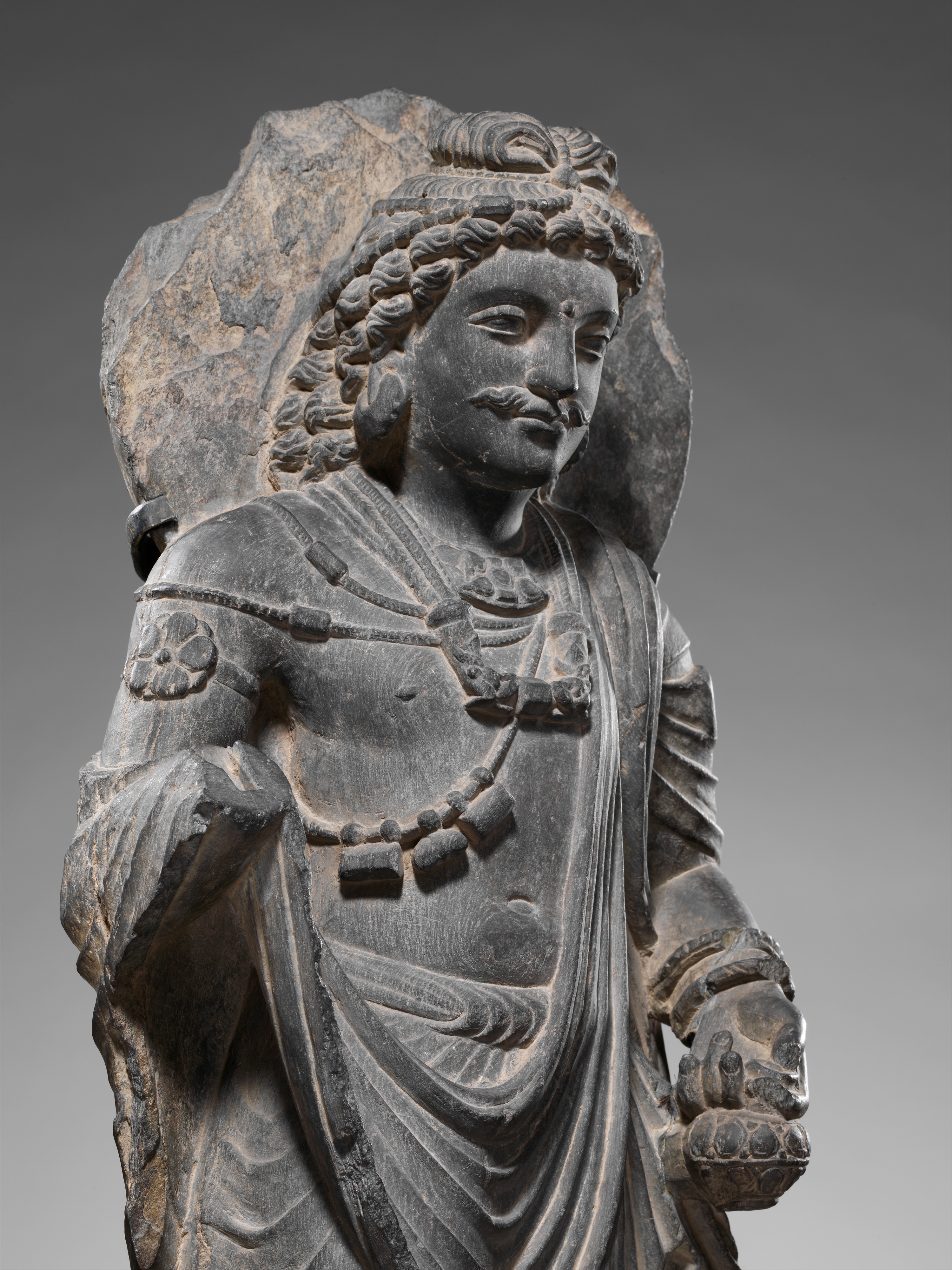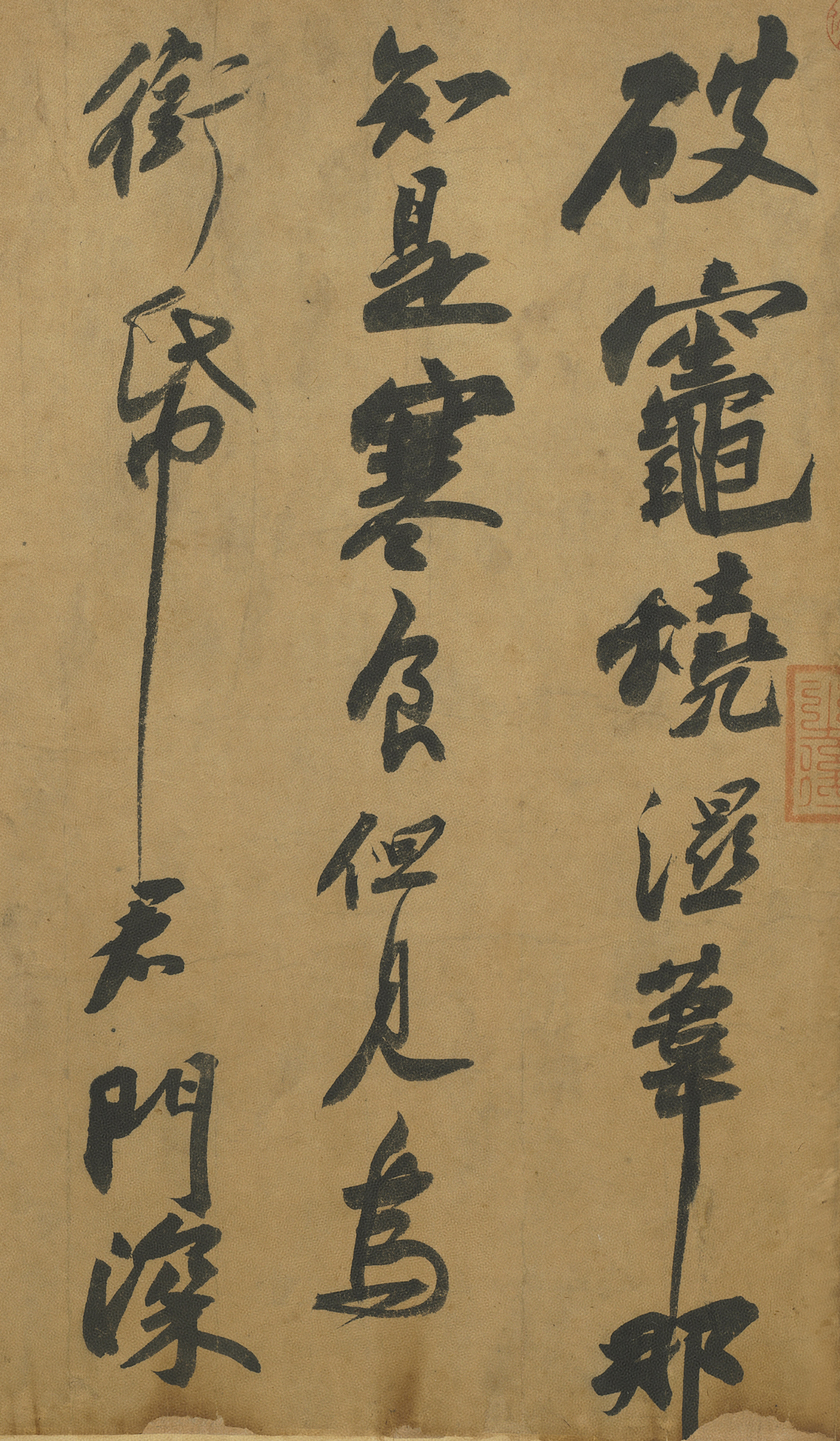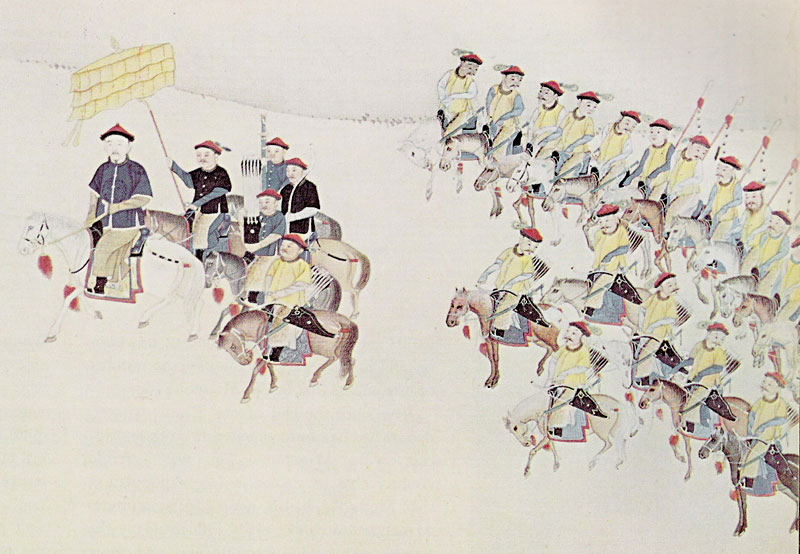|
Jingju Temple (Xinyang)
Guangshan Jingju Temple (), located in Guangshan County, Henan Province, China, also known as "Emperor entitled Brahma Temple", is the birthplace of Guangshan Jingju Temple Gate of China's first Buddhist sect, Tiantai Sect. In the fifth year of Tianbao in the Northern Qi dynasty (554 A.D.), the eminent monk Huisi came to Dasu Mountain in Guangzhou to build a nunnery and open an altar to preach. Emperor Song Zhenzong's inscription "Emperor entitled Brahma Temple" is carved with five large-character plaques, which are still embedded on the door. The Daxiong Hall in the temple is a Ming dynasty building. There are still more than 30 steles inscribed by historical celebrities and scholars such as the "Emperor's powdered gold" stele in Wanli of the Ming dynasty, and the "Reconstruction Stele of Dasushan Brahma Temple" in Kangxi of Qing dynasty. The stele of Su Shi's poems (Song dynasty) on visiting Jingju Temple is also conserved within the temple. Monks The Jingju Mountain where ... [...More Info...] [...Related Items...] OR: [Wikipedia] [Google] [Baidu] |
Guangshan County
Guangshan County (; postal: Kwangshan) is a county in the southeast of Henan province, China. It is under the administration of Xinyang city. The regional dialect is the Xinyang city dialect of Southwestern Mandarin. The 13th five-year plan of Xinyang city puts forward the concept of "integration of decoration and light", accelerates the integrated development of Huangchuan and Guangshan counties, constructs the sub central city of the city area, and supports the withdrawal of counties into cities. Administrative divisions , this county is divided to 2 subdistricts, 7 towns and 10 townships. ;Subdistricts * Xianshan Subdistrict () * Zishui Subdistrict () ;Towns ;Townships Climate History The famous historical figures born at Guangshan included Sima Guang (司马光, 1019–1086), Cai Yizhong (蔡毅中, 1567-1631), and Huxu (胡煦, 1655-1736). During the Chinese Civil War, Guangshan county was at the heart of the Eyuwan Soviet The Eyuwan Soviet. The name comes f ... [...More Info...] [...Related Items...] OR: [Wikipedia] [Google] [Baidu] |
Maitreya
Maitreya (Sanskrit) or Metteyya (Pali), is a bodhisattva who is regarded as the future Buddhahood, Buddha of this world in all schools of Buddhism, prophesied to become Maitreya Buddha or Metteyya Buddha.Williams, Paul. ''Mahayana Buddhism: The Doctrinal Foundations 2nd edition.'' Routledge, 2009, p. 218. In some Buddhist texts, Buddhist literature, such as the ''Amitabha Sutra'' and the ''Lotus Sutra'', he is also referred to as Ajitā (Invincible, Unconquerable). In Tibetan Buddhism he is known as the "Lord of Love" or the "Noble Loving One" (Pakpa Jampa). The root of his name is the Sanskrit word ''maitrī'' (Pali: ''metta''; meaning friendliness, loving-kindness). The name Maitreya is also related to the Indo-Iranian languages, Indo-Iranian name Mitra.Jayarava, Visible Mantra: Visualising & Writing Buddhist Mantras, pp. 142-43. 2011 In Hinduism, Maitreya is prophesied to be the king of Shambala, which is also the birthplace of the Kalki Avatar. In all branches of Buddhism, ... [...More Info...] [...Related Items...] OR: [Wikipedia] [Google] [Baidu] |
Temples
A temple (from the Latin ) is a place of worship, a building used for spiritual rituals and activities such as prayer and sacrifice. By convention, the specially built places of worship of some religions are commonly called "temples" in English, while those of other religions are not, even though they fulfill very similar functions. The religions for which the terms are used include the great majority of ancient religions that are now extinct, such as the Ancient Egyptian religion and the Ancient Greek religion. Among religions still active: Hinduism (whose temples are called Mandir or Kovil), Buddhism (whose temples are called Vihar), Sikhism (whose temples are called gurudwara), Jainism (whose temples are sometimes called derasar), Zoroastrianism (whose temples are sometimes called Agiary), the Baháʼí Faith (which are often simply referred to as Baháʼí House of Worship), Taoism (which are sometimes called Daoguan), Shinto (which are often called Jinja), Confu ... [...More Info...] [...Related Items...] OR: [Wikipedia] [Google] [Baidu] |
Sui Dynasty
The Sui dynasty ( ) was a short-lived Dynasties of China, Chinese imperial dynasty that ruled from 581 to 618. The re-unification of China proper under the Sui brought the Northern and Southern dynasties era to a close, ending a prolonged period of political division since the War of the Eight Princes. The Sui endeavoured to rebuild the country, re-establishing and reforming many imperial institutions; in so doing, the Sui laid much of the foundation for the subsequent Tang dynasty, who after toppling the Sui would ultimately preside over golden ages of China, a new golden age in Chinese history. Often compared to the Qin dynasty (221–206 BC), the Sui likewise unified China after a prolonged period of division, undertook wide-ranging reforms and construction projects to consolidate state power, and collapsed after a brief period. The dynasty was founded by Emperor Wen of Sui, Yang Jian (Emperor Wen), who had been a member of the military aristocracy that had developed in ... [...More Info...] [...Related Items...] OR: [Wikipedia] [Google] [Baidu] |
Zhiyi
Zhiyi (; 538–597 CE) also called Dashi Tiantai (天台大師) and Zhizhe (智者, "Wise One"), was a Chinese Bhikkhu, Buddhist monk, Buddhist philosophy, philosopher, meditation teacher, and Exegesis, exegete. He is considered to be the founder of the Tiantai Buddhist tradition, as well as its fourth Patriarch (Buddhism), patriarch. Śramaṇa Zhiyi is widely regarded as one of the most influential figures in the development of East Asian Buddhism, East Asian Buddhist thought and practice. As the first major Chinese Buddhist thinker to construct a comprehensive religious system based primarily on Chinese interpretations, Zhiyi played a crucial role in synthesizing various strands of Mahayana Buddhism into a unique coherent framework."Tiantai Zhiyi." In ''The Princeton Dictionary of Buddhism'', 911–12. Princeton University Press, 2014. http://www.jstor.org/stable/j.ctt46n41q.27. According to David W. Chappell, Zhiyi "has been ranked with Thomas Aquinas and al-Ghazali as one o ... [...More Info...] [...Related Items...] OR: [Wikipedia] [Google] [Baidu] |
Northern And Southern Dynasties
The Northern and Southern dynasties () was a period of political division in the history of China that lasted from 420 to 589, following the tumultuous era of the Sixteen Kingdoms and the Eastern Jin dynasty. It is sometimes considered as the latter part of a longer period known as the Six Dynasties (220–589). The period featured civil war and political chaos, but was also a time of flourishing arts and culture, advancement in technology, and the spread of Mahayana Buddhism and Taoism. The period saw large-scale migration of Han people to lands south of the Yangtze. The period came to an end with the unification of China proper by Emperor Wen of the Sui dynasty. During this period, the process of sinicization accelerated among the non-Han ethnicities in the north and among the indigenous peoples in the south. This process was also accompanied by the increasing popularity of Buddhism in both northern and southern China and Daoism gaining influence as well, with t ... [...More Info...] [...Related Items...] OR: [Wikipedia] [Google] [Baidu] |
Republic Of China (1912–1949)
The Republic of China (ROC) began on 1 January 1912 as a sovereign state in mainland China following the 1911 Revolution, which overthrew the Manchu people, Manchu-led Qing dynasty and ended China's imperial China, imperial history. From 1927, the Kuomintang (KMT) Northern expedition, reunified the country and initially ruled it as a one-party state with Nanjing as the national capital. In 1949, Nationalist government, the KMT-led government was defeated in the Chinese Civil War and lost control of the mainland to the Chinese Communist Party (CCP). The CCP Proclamation of the People's Republic of China, established the People's Republic of China (PRC) while the ROC was forced to Retreat of the government of the Republic of China to Taiwan, retreat to Taiwan; the ROC retains control over the Taiwan Area, and political status of Taiwan, its political status remains disputed. The ROC is recorded as a founding member of both the League of Nations and the United Nations, and previous ... [...More Info...] [...Related Items...] OR: [Wikipedia] [Google] [Baidu] |
Qing Dynasty
The Qing dynasty ( ), officially the Great Qing, was a Manchu-led Dynasties of China, imperial dynasty of China and an early modern empire in East Asia. The last imperial dynasty in Chinese history, the Qing dynasty was preceded by the Ming dynasty and succeeded by the Republic of China (1912–1949), Republic of China. At its height of power, the empire stretched from the Sea of Japan in the east to the Pamir Mountains in the west, and from the Mongolian Plateau in the north to the South China Sea in the south. Originally emerging from the Later Jin (1616–1636), Later Jin dynasty founded in 1616 and proclaimed in Shenyang in 1636, the dynasty seized control of the Ming capital Beijing and North China in 1644, traditionally considered the start of the dynasty's rule. The dynasty lasted until the Xinhai Revolution of October 1911 led to the abdication of the last emperor in February 1912. The multi-ethnic Qing dynasty Legacy of the Qing dynasty, assembled the territoria ... [...More Info...] [...Related Items...] OR: [Wikipedia] [Google] [Baidu] |
Su Shi
Su Shi ( zh, t=, s=苏轼, p=Sū Shì; 8 January 1037 – 24 August 1101), courtesy name Zizhan (), art name Dongpo (), was a Chinese poet, essayist, calligrapher, painter, scholar-official, literatus, artist, pharmacologist, and gastronome who lived during the Song dynasty. A major personality of the Song era, Su was an important figure in History of the Song Dynasty#Partisans and factions, reformers and conservatives, Song Dynasty politics, he had a lengthy career in bureaucracy, taking various provincial posts and briefly serving as a senior official at the imperial court. Despite his high hopes to serve the country, Su's political career was filled with frustrations due to his out-spoken criticism, and he often fell victim to political rivalries between the radical and the conservative forces. He endured a series of political exiles during which his creative career flourished. Su is widely regarded as one of the most accomplished figures in classical Chinese literature, lea ... [...More Info...] [...Related Items...] OR: [Wikipedia] [Google] [Baidu] |
Henan
Henan; alternatively Honan is a province in Central China. Henan is home to many heritage sites, including Yinxu, the ruins of the final capital of the Shang dynasty () and the Shaolin Temple. Four of the historical capitals of China, Luoyang, Anyang, Kaifeng and Zhengzhou, are in Henan. While the province's name means 'south of the river', approximately a quarter of the province lies north of the Yellow River. With an area of , Henan covers a large part of the fertile and densely populated North China Plain. Its neighboring provinces are Shaanxi, Shanxi, Hebei, Shandong, Anhui, and Hubei. Henan is China's third-most populous province and the most populous among inland provinces, with a population of over 99 million as of 2020. It is also the world's seventh-most populous administrative division; if it were a country by itself, Henan would be the 17th-most populous in the world, behind Egypt and Vietnam. People from Henan often suffer from regional discrimination ... [...More Info...] [...Related Items...] OR: [Wikipedia] [Google] [Baidu] |
Kangxi Emperor
The Kangxi Emperor (4 May 165420 December 1722), also known by his temple name Emperor Shengzu of Qing, personal name Xuanye, was the third emperor of the Qing dynasty, and the second Qing emperor to rule over China proper. His reign of 61 years makes him the longest-reigning emperor in Chinese history and one of the longest-reigning rulers in history. He is considered one of China's greatest emperors. The third son of the Shunzhi Emperor, Kangxi was enthroned at the age of seven while actual power was held for six more years by the four regents nominated by his father. After assuming personal rule, Kangxi's attempt to revoke the fiefdoms of feudal princes sparked the Revolt of the Three Feudatories, which he suppressed. He also forced the Kingdom of Tungning in Taiwan and Mongols in the north and northwest to submit to Qing rule, and launched an expedition that incorporated Tibet into the empire. Domestically, he initially welcomed the Jesuits and the propagation of ... [...More Info...] [...Related Items...] OR: [Wikipedia] [Google] [Baidu] |







